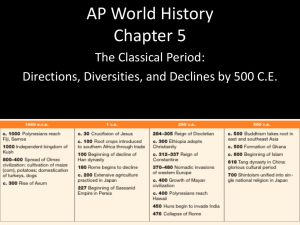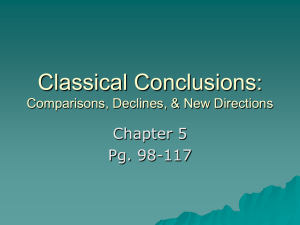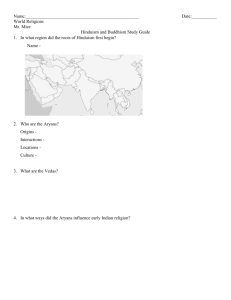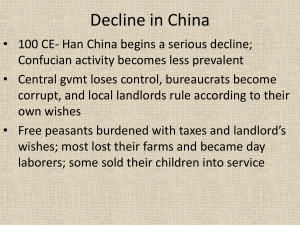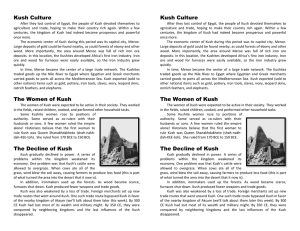AP World History Chapter 5
advertisement
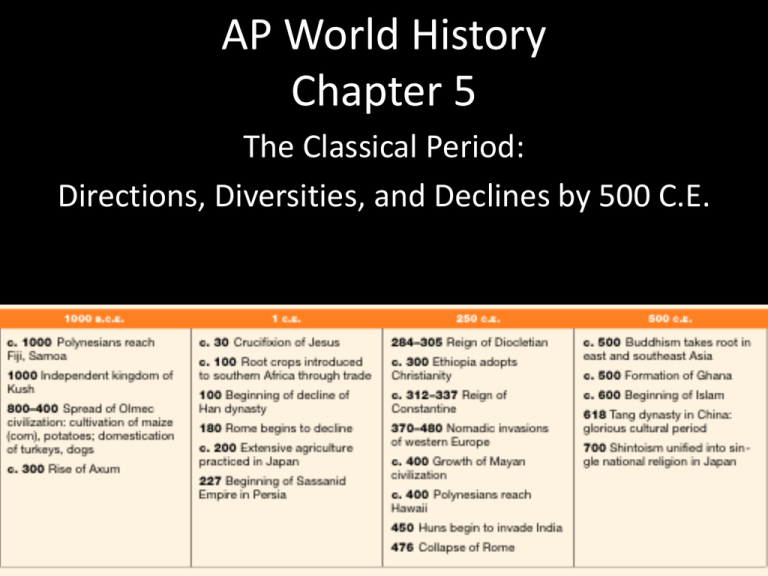
AP World History Chapter 5 The Classical Period: Directions, Diversities, and Declines by 500 C.E. Independent developments 600 C.E. • Sub-Saharan Africa – Upper Nile Region • Kush – Kush and Upper Nile Region Unified by 1000 B.C. • Axum – conquers Kush by 300 B.C.E. • Ethiopia – conquest of Axum – Trade with Mediterranean – some converts to Judaism – Christianity by 300 C.E. • West Africa – Southern fringe of Sahara civilization – Regional kingdoms – Ghana Independent developments 600 C.E. • Japan – Agriculture well-established by 200 C.E. – Regional states, c. 300 C.E. – Writing introduced 400 C.E. Shintoism (Religion) – Organized by 700 C.E. – State formation by 600 C.E. • Northern Europe – Germanic, Celtic, Slavic peoples – loose kingdoms – – – – oral culture simple agriculture Sailing Animistic • Central America • Olmec, c. 800–400 B.C.E. – – – – – – No writing Pyramids Agriculture Especially corn Potatoes in Andes Domestication of animals – Turkeys, dogs – Calendars • Successor Cultures • Teotihuacan • Maya – from 400 C.E. Polynesia Isolation – Fiji, Samoa, and Tonga by 1000 B.C.E. – Hawaii by 400 C.E. China Decline • Han Dynasty – decline ca. 100 C.E. – Daoist revival – Yellow Turbans – Epidemics • Sui Dynasty • Tang – from 618 C.E. – Continuity India Decline • Invasions from 600 C.E. – Gupta empire destroyed • Fragmentation – Rajput • Buddhism declines • Hinduism – worship of Devi popular • Islam – from 7th century – control of Indian Ocean Decline and Fall in Rome • Leadership • weak emperors Plagues • Change from republican values hedonism • Diocletian (284–305 C.E.) emperor worship • Constantine (312–337 C.E.) Constantinople Two Empires Eastern • Population – Greek • • • • • Constantinople Continuity, vigor Byzantine Empire Justinian (527–565 C.E.) Justinian Code Western • Population – Latin, Germanic • Rome • decline, vulnerable Western Europe Contributing to Fall of Rome • Middle East – Parthian Empire • Sassanids – from 227 C.E. – Zoroastrianism – D. North Africa • Augustine – bishop of Hippo – Coptic church The New Religious Map • Common Features – – – – Piety spiritual focus Afterlife emerge in period of political instability • Hinduism, Buddhism, and Daoism • Buddhism – changes as it spreads – Bodhisattvas – nirvana • Mahayana – China, Korea, Japan – minority religion Christianity • Institutional church – Roman influence – Papacy – bishops • Jesus of Nazareth – Salvation – Spread – Paul • Doctrine – trinity • Monasticism – Benedict of Nursia Rule • Women – spiritual equals of men • Islam – Later, 7th century • D. The Spread of Major Religions – Animism declines • E. The World Around 500 C.E.
